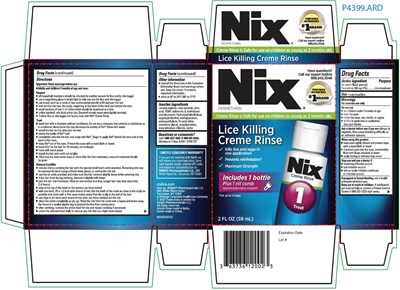Product Images Nix Lice Killing Creme Rinse
View Photos of Packaging, Labels & Appearance
Product Label Images
The following 2 images provide visual information about the product associated with Nix Lice Killing Creme Rinse NDC 63471-3006 by Geodis Logistics Llc, such as packaging, labeling, and the appearance of the drug itself. This resource could be helpful for medical professionals, pharmacists, and patients seeking to verify medication information and ensure they have the correct product.
Label0 - Label0

This is a detailed drug facts sheet providing directions on how to use Nix® Creme Rinse to treat lice and nits in adults and children over 2 months old. The instructions include checking for lice, applying the product, combing out nits, and additional information such as storage conditions and customer support contact details. The active ingredient is Permethrin, and precautions are mentioned for sensitive areas like eyes and advice to seek medical help in case of specific symptoms like breathing difficulty or skin irritation. The product contains specific inactive ingredients and comes with a limited consumer warranty. Instructions in Spanish are also included, and the product is stated to be made in India.*
Label02 - Label02

This is a description of a lice treatment product in cream rinse form. The active ingredient is Permethrin 1%. It is used to treat head lice and is effective in killing lice and eggs in one application, preventing reinfestation for up to 14 days. The product comes in a 2FL OZ (59 mL) bottle. The directions for use involve washing hair with a specific shampoo, applying the cream rinse thoroughly to hair and scalp, leaving it on for 10 minutes, and then washing it off. There are warnings provided regarding the use of the product, including avoiding contact with eyes and sensitive areas. It is advisable to consult a doctor before use if allergic to ragweed or if pregnant or breastfeeding. Additionally, the product should be kept out of reach of children and medical help should be sought if accidentally swallowed.*
* The product label images have been analyzed using a combination of traditional computing and machine learning techniques. It should be noted that the descriptions provided may not be entirely accurate as they are experimental in nature. Use the information in this page at your own discretion and risk.